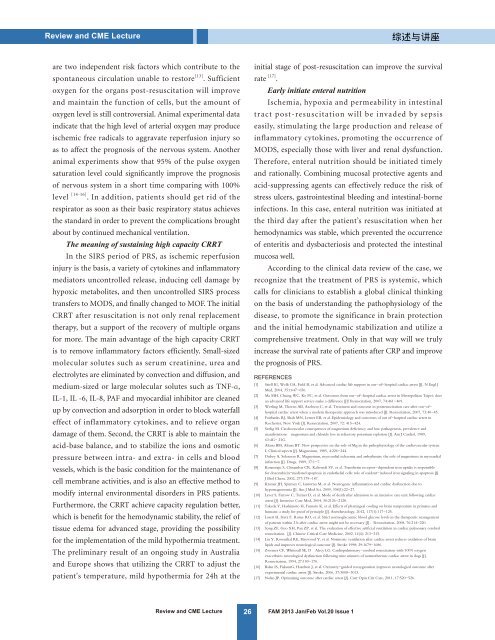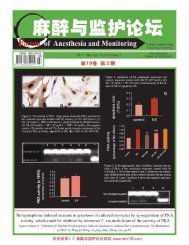ç¹å»æ¥ç - 麻éä¸çæ¤è®ºå
ç¹å»æ¥ç - 麻éä¸çæ¤è®ºå
ç¹å»æ¥ç - 麻éä¸çæ¤è®ºå
- No tags were found...
You also want an ePaper? Increase the reach of your titles
YUMPU automatically turns print PDFs into web optimized ePapers that Google loves.
Review and CME Lectureare two independent risk factors which contribute to thespontaneous circulation unable to restore [13] . Sufficientoxygen for the organs post-resuscitation will improveand maintain the function of cells, but the amount ofoxygen level is still controversial. Animal experimental dataindicate that the high level of arterial oxygen may produceischemic free radicals to aggravate reperfusion injury soas to affect the prognosis of the nervous system. Anotheranimal experiments show that 95% of the pulse oxygensaturation level could significantly improve the prognosisof nervous system in a short time comparing with 100%level [14-16] . In addition, patients should get rid of therespirator as soon as their basic respiratory status achievesthe standard in order to prevent the complications broughtabout by continued mechanical ventilation.The meaning of sustaining high capacity CRRTIn the SIRS period of PRS, as ischemic reperfusioninjury is the basis, a variety of cytokines and inflammatorymediators uncontrolled release, inducing cell damage byhypoxic metabolites, and then uncontrolled SIRS processtransfers to MODS, and finally changed to MOF. The initialCRRT after resuscitation is not only renal replacementtherapy, but a support of the recovery of multiple organsfor more. The main advantage of the high capacity CRRTis to remove inflammatory factors efficiently. Small-sizedmolecular solutes such as serum creatinine, urea andelectrolytes are eliminated by convection and diffusion, andmedium-sized or large molecular solutes such as TNF-ɑ,IL-1, IL -6, IL-8, PAF and myocardial inhibitor are cleanedup by convection and adsorption in order to block waterfalleffect of inflammatory cytokines, and to relieve organdamage of them. Second, the CRRT is able to maintain theacid-base balance, and to stabilize the ions and osmoticpressure between intra- and extra- in cells and bloodvessels, which is the basic condition for the maintenance ofcell membrane activities, and is also an effective method tomodify internal environmental disorders in PRS patients.Furthermore, the CRRT achieve capacity regulation better,which is benefit for the hemodynamic stability, the relief oftissue edema for advanced stage, providing the possibilityfor the implementation of the mild hypothermia treatment.The preliminary result of an ongoing study in Australiaand Europe shows that utilizing the CRRT to adjust thepatient's temperature, mild hypothermia for 24h at theinitial stage of post-resuscitation can improve the survivalrate [17] .Early initiate enteral nutritionIschemia, hypoxia and permeability in intestinaltract post-resuscitation will be invaded by sepsiseasily, stimulating the large production and release ofinflammatory cytokines, promoting the occurrence ofMODS, especially those with liver and renal dysfunction.Therefore, enteral nutrition should be initiated timelyand rationally. Combining mucosal protective agents andacid-suppressing agents can effectively reduce the risk ofstress ulcers, gastrointestinal bleeding and intestinal-borneinfections. In this case, enteral nutrition was initiated atthe third day after the patient’s resuscitation when herhemodynamics was stable, which prevented the occurrenceof enteritis and dysbacteriosis and protected the intestinalmucosa well.According to the clinical data review of the case, werecognize that the treatment of PRS is systemic, whichcalls for clinicians to establish a global clinical thinkingon the basis of understanding the pathophysiology of thedisease, to promote the significance in brain protectionand the initial hemodynamic stabilization and utilize acomprehensive treatment. Only in that way will we trulyincrease the survival rate of patients after CRP and improvethe prognosis of PRS.REFERENCES[1] Stiell IG, Wells GA, Field B, et al. Advanced cardiac life support in out-of-hospital cardiac arrest [J]. N Engl JMed, 2004, 351:647-656.[2] Ma MH, Chiang WC, Ko PC, et al. Outcomes from out-of-hospital cardiac arrest in Metropolitan Taipei: doesan advanced life support service make a difference [J]? Resuscitation, 2007, 74:461-469.[3] Werling M, Thoren AB, Axelsson C, et al. Treatment and outcome in postresuscitation care after out-ofhospitalcardiac arrest when a modern therapeutic approach was introduced [J]. Resuscitation, 2007, 73:40-45.[4] Fairbanks RJ, Shah MN, Lerner EB, et al. Epidemiology and outcomes of out of-hospital cardiac arrest inRochester, New York [J]. Resuscitation, 2007, 72: 415-424.[5] Seelig M. Cardiovascular consequences of magnesium deficiency and loss: pathogenesis, prevalence andmanifestations—magnesium and chloride loss in refractory potassium repletion [J]. Am J Cardiol, 1989,63:4G- 21G.[6] Altura BM, Altura BT. New perspective on the role of Mg in the pathophysiology of the cardiovascular system.I. Clinical aspects [J]. Magnesium, 1985, 4:226-244.[7] Dubey A, Solomon R. Magnesium, myocardial ischaemia and arrhythmias: the role of magnesium in myocardialinfarction [J]. Drugs, 1989, 37:1-7.[8] Kotamraju S, Chitambar CR, Kalivendi SV, et al. Transferrin receptor-dependent iron uptake is responsiblefor doxorubicin-mediated apoptosis in endothelial cells: role of oxidant-induced iron signaling in apoptosis [J].J Biol Chem, 2002, 277:179-187.[9] Kramer JH, Spurney C, Iantorno M, et al. Neurogenic inflammation and cardiac dysfunction due tohypomagnesemia [J]. Am J Med Sci, 2009, 338(1):22-27.[10] Laver S, Farrow C, Turner D, et al. Mode of death after admission to an intensive care unit following cardiacarrest [J]. Intensive Care Med, 2004, 30:2126-2128.[11] Takeda Y, Hashimoto H, Fumoto K, et al. Effects of pharyngeal cooling on brain temperature in primates andhumans: a study for proof of principle [J]. Anesthesiology, 2012, 117(1):117-125.[12] Losert H, Sterz F, Roine RO, et al. Strict normoglycaemic blood glucose levels in the therapeutic managementof patients within 2 h after cardiac arrest might not be necessary [J] . Resuscitation, 2008, 76:214-220.[13] Song ZF, Guo XH, Pan ZP, et al. The evaluation of effective artificial ventilation in cardiac pulmonary cerebralresuscitation. [J]. Chinese Critical Care Medicine, 2002, 14(4): 213-215.[14] Liu Y, Rosenthal RE, Haywood Y, et al. Normoxic ventilation after cardiac arrest reduces oxidation of brainlipids and improves neurological outcome [J]. Stroke 1998; 29:1679-1686.[15] Zwemer CF, Whitesall SE, D’Alecy LG. Cardiopulmonary-cerebral resuscitation with 100% oxygenexacerbates neurological dysfunction following nine minutes of normothermic cardiac arrest in dogs [J].Resuscitation, 1994, 27:159-170.[16] Balan IS, FiskumG, Hazelton J, et al. Oximetry-guided reoxygenation improves neurological outcome afterexperimental cardiac arrest [J]. Stroke, 2006, 37:3008-3013.[17] Nolan JP. Optimizing outcome after cardiac arrest [J]. Curr Opin Crit Care, 2011, 17:520-526.Laboratory Review and Clinical and CME Investigation Lecture 26 FAM 2013 Jan/Feb Vol.20 Issue 1123



